Ready to create a thriving organic garden? Start by pairing vibrant plants like tomatoes and basil—together, they’ll boost flavors and ward off pests! Don’t forget your marigolds; they’re like your garden’s little bodyguards, tackling bad bugs fiercely! Try layering fast-growing radishes with slow-maturing carrots to maximize space and yield! With a little planning and creativity, you’ll cultivate a lush paradise. Intrigued? Stick around, and we’ll explore even more tips to elevate your gardening game!
Understanding Companion Planting Basics
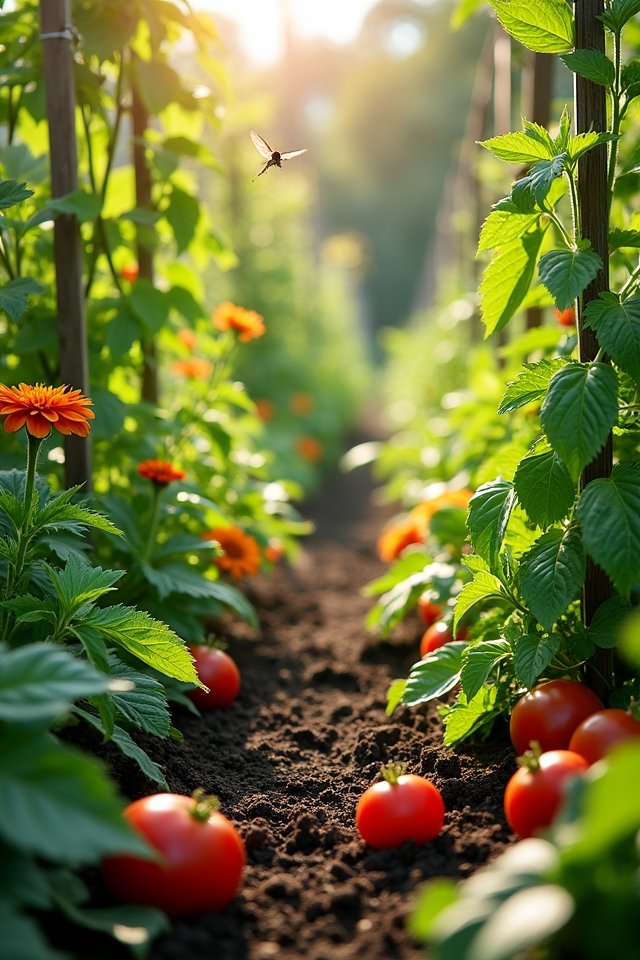
When it comes to creating a thriving organic garden, companion planting is like matchmaking for your plants—bringing together those who’ll really hit it off! Think of it as forming fantastic friendships between plants, where each buddy supports the other’s growth. For example, when you plant tomatoes alongside basil, they create plant relationships that repel pests and enhance flavors—it’s a win-win! You’ll also discover that marigolds and nasturtiums can ward off harmful insects while attracting pollinators. These innovative pairings result in remarkable growth benefits, like healthier veggies and vibrant blooms. So, why settle for lonely plants? Instead, let your garden be a vibrant community, fostering connections that lead to organic abundance and delightful surprises all season long!
Selecting Compatible Plants
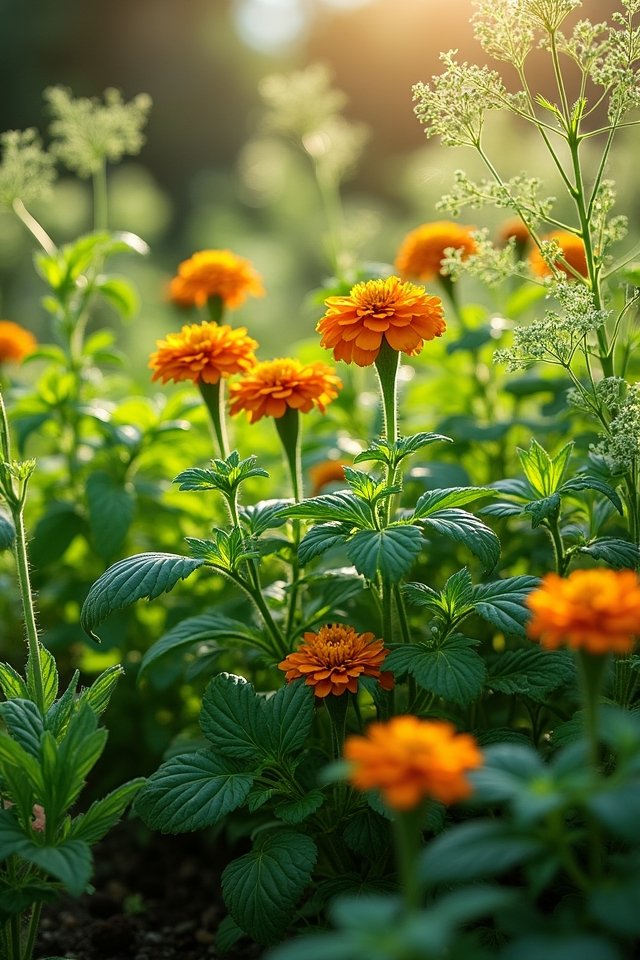
Choosing compatible plants isn’t just about mixing and matching; it’s like throwing a fabulous garden party! You wouldn’t invite just anyone, right? Consider delightful plant pairings that complement each other, like tomatoes and basil—together, they create stunning flavors! Think about color compatibility too; for instance, the vibrant yellow of marigolds pops against deep green leafy veggies. It’s all about visual synergy! When you design your garden, ask yourself, “Will this trio create a feast for the eyes?” Or imagine the bright blues of borage nestled among sunny nasturtiums—talk about a showstopper! So get creative, trust your instincts, and remember: just like in a great party, the right mix can lead to unforgettable experiences!
Enhancing Soil Health With Companion Plants
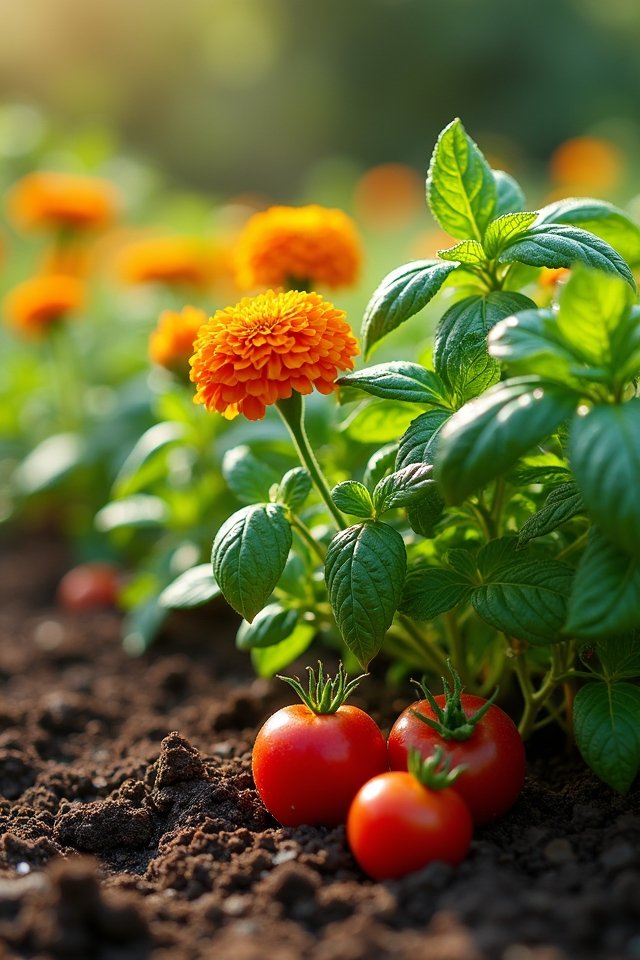
While planting your garden, you might be surprised how much companion plants can boost soil health! Think of them as the little superheroes of your soil! By partnering with certain plants, you invite beneficial soil microorganisms that enhance nutrient cycling. For instance, legumes like peas add nitrogen to the soil, feeding your garden’s hungry plants. Meanwhile, deep-rooted plants like dandelions pull up nutrients from the depths, making them available to shallow-rooted neighbors. Imagine a bustling community of roots, all working together to create a rich, organic tapestry! Plus, these companions increase organic matter, improving moisture retention. Who knew your garden could be so innovative? So, let’s bring on the companions and watch your soil thrive like never before!
Natural Pest Control Through Companion Planting
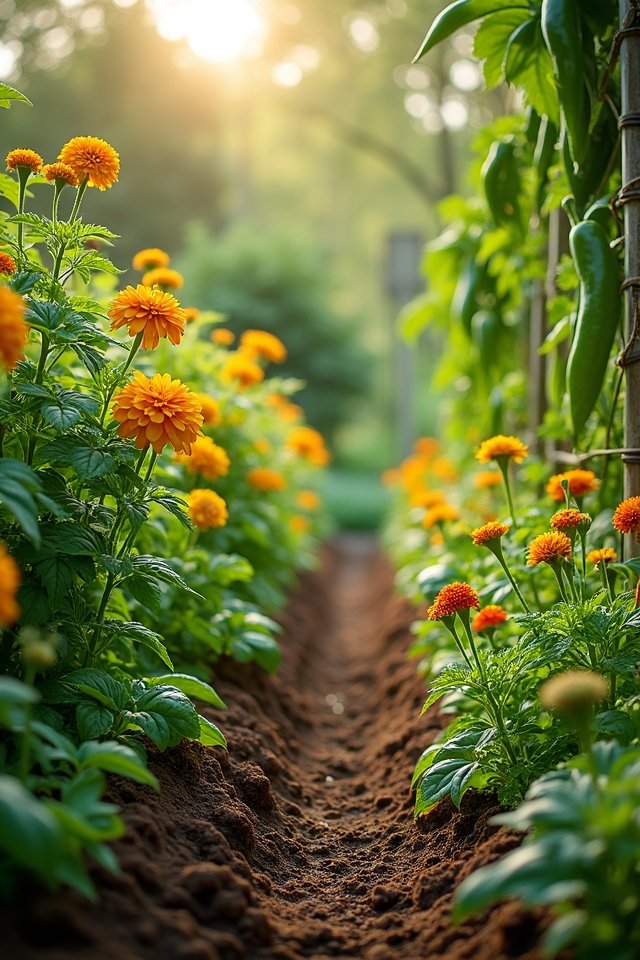
Imagine your garden as a bustling city, with each plant playing its part to keep the peace. You can harness nature’s superstars for natural pest control! Here’s how to attract beneficial insects while knocking out those pesky critters:
- Marigolds: Plant them near vegetables. Their scent keeps bad bugs at bay!
- Nasturtiums: These colorful beauties are trap crops for aphids, drawing them away from your prized plants.
- Basil and Tomatoes: This dynamic duo repels hornworms and flies, promoting a healthy crop.
- Sunflowers: Apart from their beauty, they attract pollinators and beneficial insects that feast on harmful pests.
Embrace companion planting, and let your garden thrive naturally! Why not give it a try? Your plants (and your peace of mind) will thank you!
Maximizing Space and Yield in Your Garden
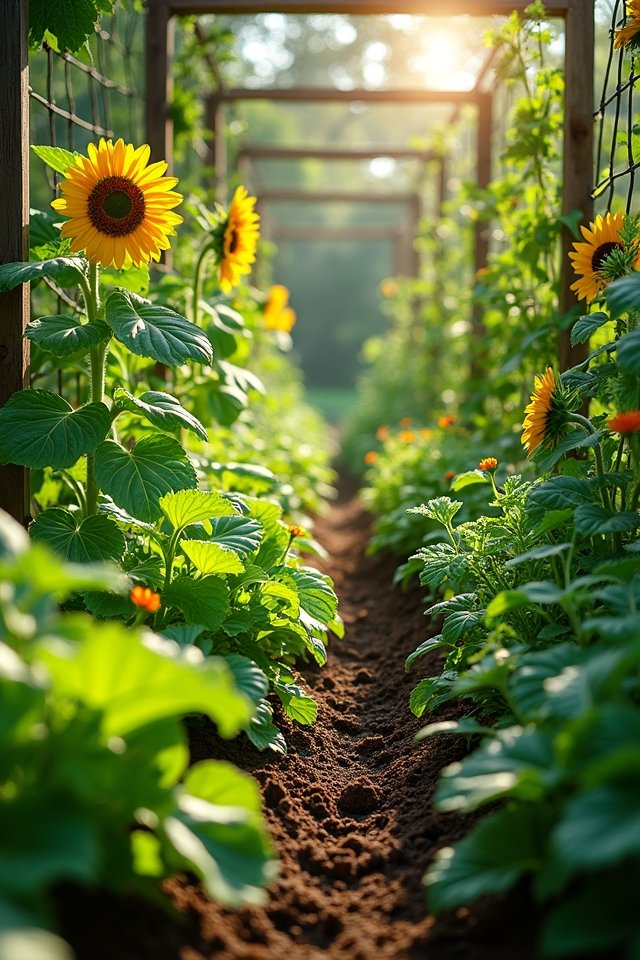
When you’re crunched for space (and who isn’t in those glorious gardening adventures?), maximizing your garden’s potential can feel like a thrilling puzzle! Think vertical gardening—it’s like giving your plants a tall friend to chat with! Utilize trellises for peas and cucumbers; they’ll climb high while you garden below, saving precious ground. Also, adopt intercropping strategies! Try pairing fast-growing radishes with slower sprouts like carrots. The radishes’ll be out of the way before the carrots need their space, leveraging every inch of soil! You’ll find colorful carrots peeking around lush greenery, creating a whimsical tapestry of growth! So, grab those plants, get creative with layers, and watch how your compact garden bursts with life—it’s practically a botanical magic show!
Seasonal Considerations for Companion Planting
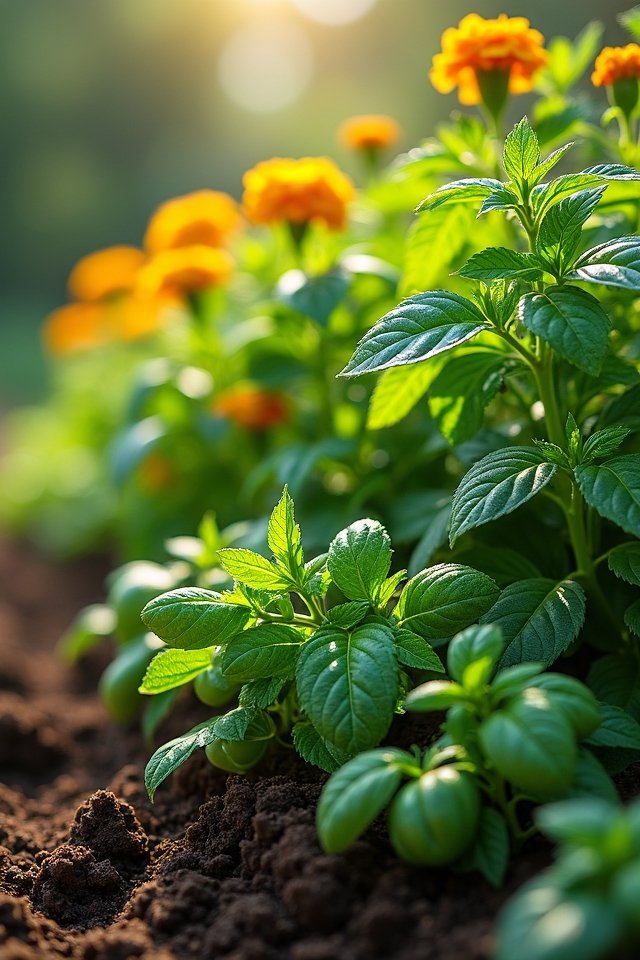
As you lay your plans for that bustling garden, don’t overlook how the seasons influence your companion planting choices! Your success in spring planting isn’t just about the veggies, but about who they’ll thrive with! Each season brings its quirks—so let’s maximize our potential.
- Spring: Pair tomatoes with basil for a fragrant and productive duo!
- Summer: Use marigolds to deter pesky pests while attracting pollinators.
- Fall: Plant cover crops like clover to enrich the soil before winter.
- Winter: Consider cold frames to extend your growing season with kale and spinach!
Observing and Adjusting for Optimal Results
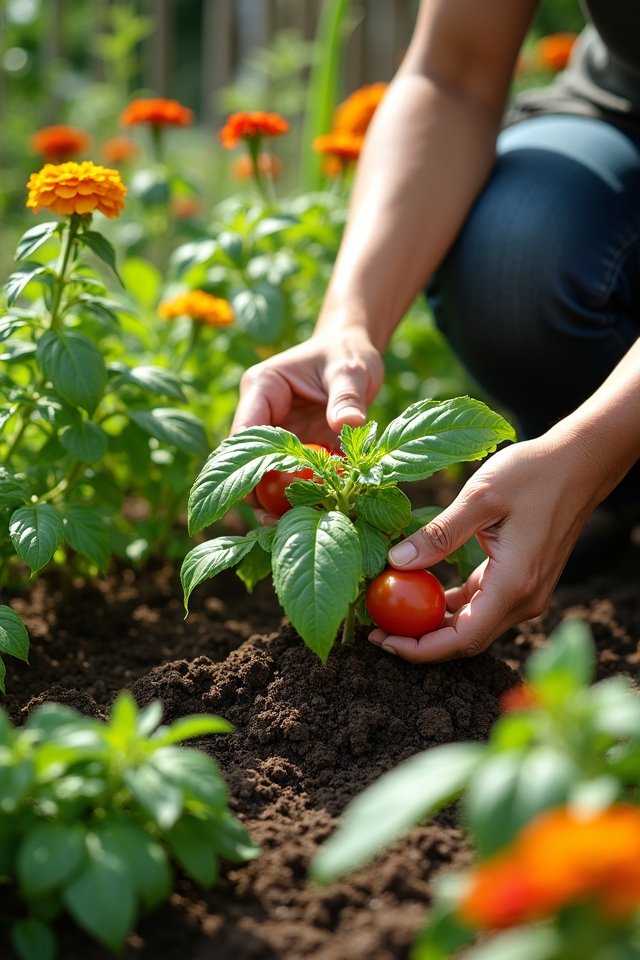
Diving into your garden, you might find that observing your plants is like tuning into a lively conversation! Each one whispers secrets of plant growth and condition. Look for vibrant colors, healthy leaves, or the tiniest pests playing tag on your tomatoes! These garden observations can be your roadmap to success. If your carrots seem shy, try moving them next to some brave marigolds—those beauties can keep pests at bay! Feeling the soil’s texture reveals if it needs a drink or a boost. Adjusting what you see makes all the difference. Keep a journal to track changes and discoveries! It’s like having a backstage pass to your garden’s innovative performance! So, roll up your sleeves, and let those observations guide you!
Frequently Asked Questions
What Are the Best Companion Plants for Tomatoes?
So, you think tomatoes can thrive all alone? Think again! Tomato companions like basil and marigold aren’t just pretty faces; they’re your little pest deterrents! Basil enhances their flavor, while marigolds repel those pesky aphids. Imagine a vibrant garden party, where these plants create a delightful symphony of growth! Plus, planting garlic nearby scares off harmful insects. So grab those friends for your tomatoes, and let the magic of synergy unfold!
Can I Plant Herbs With Vegetables?
Absolutely, you can! Planting herbs with vegetables brings a garden to life, almost like creating a colorful art piece! Think about basil with tomatoes—it’s a classic duo that enhances flavor and wards off pests. Or imagine mint’s invigorating scent mingling with your peas—it’s like a lovely garden hug! Just remember, herbs like rosemary prefer their space, so choose compatible pals wisely! Isn’t it fun how nature’s friendships can boost your harvest?
How Does Companion Planting Affect Crop Rotation?
Companion planting jazzes up your crop rotation! By mixing diverse plants, you create a symphony of crop diversity that boosts soil health. Imagine a bustling garden where beans dance with corn, fixing nitrogen in the soil, while marigolds keep pests at bay. Isn’t that delightful? Plus, rotating these harmonious pairings prevents nutrient depletion, just like swapping instruments in a band. So, get creative! Your garden will sing with energy and abundance!
Are There Any Companion Plant Combinations to Avoid?
Watch out for those incompatible pairings! Planting tomatoes and potatoes together is like inviting a bully to a party—it’s a harmful mixture! They compete for nutrients, leaving both sad and droopy. Also, be cautious with beans and onions; that combo’s a recipe for disaster! Imagine beans running from angry onions! Stick to friendly companions that giggle in harmony, and your garden will be a vibrant oasis instead of a drama scene!
What Resources Can Help Me Learn More About Companion Planting?
Ready to plunge into companion planting? Grab some books like “Carrots Love Tomatoes” for a fun start! You’ll find online courses that turn your garden into a magical landscape. Don’t forget those engaging videos bursting with visual delights! And gardening forums? They’re treasure troves of wisdom, buzzing with fellow plant lovers. So, why not explore and share experiences? Each resource could be your garden’s secret weapon for lush growth and flavor! Happy planting!


